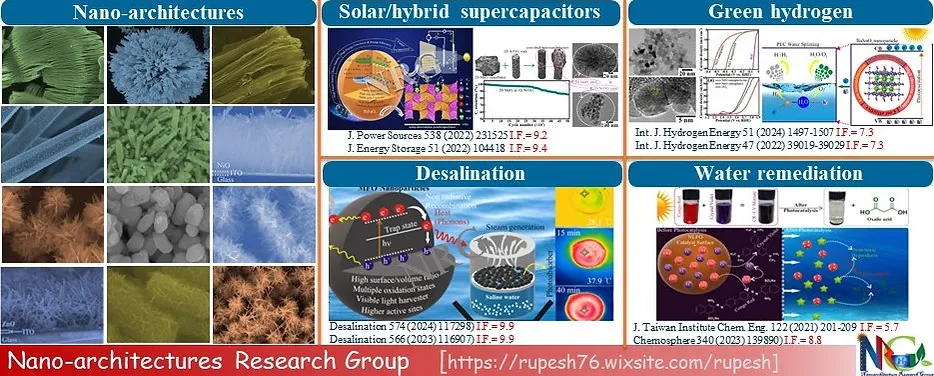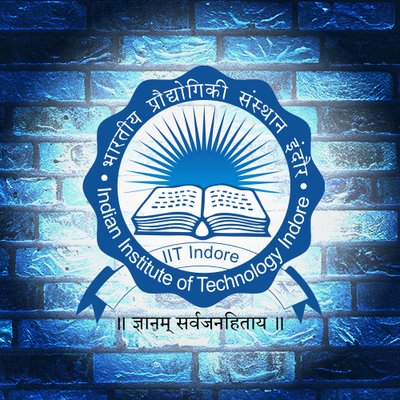Research Interest

Nano-hetero-architectures
Developing novel functional materials and devices with controlled features on the nanometer scale is at the core of R&D innovation. Nano-heterostructures and hetero-junctions are gaining tremendous pull in today’s technology. In our group, we strategically grow nano-hetero-architectures with demarcated and diversified morphologies to fulfill the nano-structuring demand of every scientific field. When two distinctive materials of choice are downscaled to nano to form hetero architectures, the synergy between the two materials commendably enhances the efficacy of a targeted specific application. Our group focuses on developing new nano-hetero-architectures and growth strategies with control over their dimensions and shapes for targeted applications, particularly in the green and sustainable energy sectors.
2D Materials (MXenes and TMDs)
Our research group is actively investigating the properties of two-dimensional (2D) materials, focusing mainly on Transition Metal Dichalcogenides (TMDs) and MXenes. These materials exhibit unique characteristics that make them highly suitable for various energy storage and conversion applications, including supercapacitors, batteries, and photoelectrochemical (PEC) water splitting. TMDs, with their atomically thin layers and tuneable electronic properties, offer promising avenues for enhancing the performance of energy storage devices like supercapacitors and batteries. Similarly, MXenes, derived from layered transition metal carbides and nitrides (i.e., MAX Phase), demonstrate excellent conductivity and large surface areas, making them ideal candidates for improving the efficiency of energy conversion processes such as PEC water splitting. Through our exploration of these advanced 2D materials, we aim to contribute to the development of sustainable and efficient energy technologies.
Materials for energy conversion and storage
The demand for sustainable energy is increasing rapidly, which requires the development of devices that can store and convert energy with high efficiency and adopt carbon-free environment. Our group aims to employ advanced, cheap, and durable novel nanostructures to fabricate hybrid supercapacitors that can evolve as a prudential strategy to catch up with conventional chemical power sources such as batteries and provide high power and energy density and a long life cycle. At the same time, we are trying to pursue cost-effective design methods and device architecture without compromising performance efficiency. We also develop light-assisted charging devices, a marvelous hybrid technology, i.e., solar electrochemical capacitors incorporating both photoelectric conversion and energy storage in a single device. We also aim to work on providing new insights into the mechanism of interface engineering and photo-activity of heterojunctions under illumination for enhanced photoelectrochemical energy storage performance.
Green Hydrogen
In this era of modernization and industrialization, the entire scientific community is invested in the concept of sustainability and eco-friendly environmental conditions for the existence of mankind. Looking forward and taking into consideration the concept of sustainable and cleaner environment, Green H2 production has acquired a lot of attention and is a booming concept to ponder upon. This process of green H2 generation uses solar energy to break water into H2 and O2. Green H2 can also be justified as completely clean energy source as it only gives water vapor as the side product, leaving no harmful residue, unlike other fossil fuels. Our group mainly focuses on photoelectrochemical water splitting by employing advanced, cheap, and novel nanostructures. The major research revolves around tuning the bandgap, controlling the morphology and size of the photocatalyst, and ultimately aiming to improve the overall solar-to-hydrogen energy conversion efficiency more efficiently and sustainably. So far, we have explored MXenes, TMDs, MO, and MOF for this purpose.
Desalination &Water Remediation
To deal with the majority of the challenges confronting humanity in the 21st century concerning the quantity and quality of water, photothermal desalination and/or photocatalytic organic dye removal under abundantly available sunlight, without producing chemical waste, usually infeasible in other traditional methods, have emerged as cost-effective, sustainable, and environment-friendly methods to produce clean water. We are mainly focusing on the synthesis of various morphological forms of metal oxides for the removal of numerous cationic and anionic organic dyes from wastewater under laboratory-scale test reactors. The non-toxic by-products during the reactions are identified utilizing Liquid Chromatography Mass Spectroscopy (LCMS) analysis. Similarly, various photothermal materials are explored for the desalination of salty and dye contaminated water by means of solar to steam generation under light exposure by measuring the mass loss and surface temperature using different membranes. Along with this, the electro-kinetic measurements are also conducted for the direct electricity conversion via salt water.
